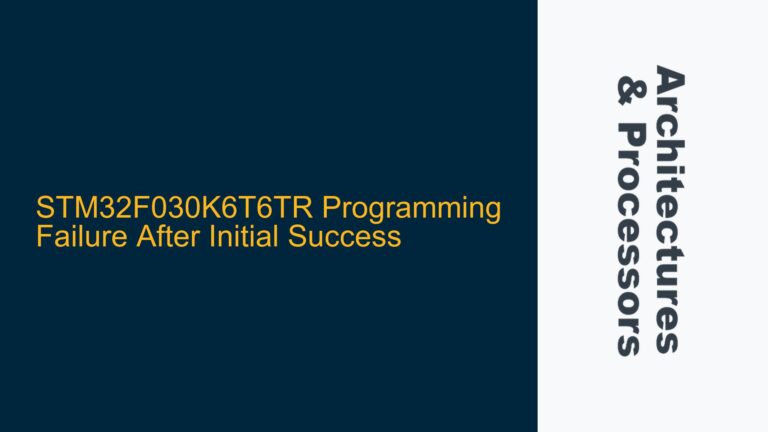Cortex A9 ACP Slave Outstanding Read Request Handling
The Cortex A9 Accelerator Coherency Port (ACP) is a critical interface for enabling efficient data sharing between the processor and external accelerators or DMA engines. The ACP allows these external agents to access the Cortex A9’s cache-coherent memory subsystem, ensuring data consistency without requiring explicit cache maintenance operations. However, the ACP’s ability to handle outstanding read requests is a key performance determinant, especially in high-throughput systems where multiple read requests may be issued concurrently.
In the Cortex A9 architecture, the ACP operates as an AXI3 slave interface, which inherently supports multiple outstanding transactions. However, the actual number of outstanding read requests that the ACP can handle is not explicitly documented in the Cortex A9 Technical Reference Manual (TRM). This lack of documentation can lead to performance bottlenecks, particularly when the system is designed under the assumption that the ACP can handle a higher number of outstanding requests than it actually supports.
The ACP’s ability to handle outstanding read requests is influenced by several factors, including the AXI3 protocol’s capabilities, the SCU (Snoop Control Unit) implementation, and the specific configuration of the Cortex A9 core. The SCU, which manages cache coherency and ACP transactions, plays a crucial role in determining the ACP’s performance characteristics. If the SCU is configured to handle only a limited number of outstanding requests, this can become a bottleneck, especially in systems where high data throughput is required.
Memory Subsystem Constraints and AXI3 Protocol Limitations
The Cortex A9 ACP’s ability to handle outstanding read requests is constrained by both the memory subsystem and the AXI3 protocol. The AXI3 protocol supports multiple outstanding transactions through the use of transaction IDs, which allow the interconnect to manage and reorder transactions. However, the actual number of outstanding requests that can be handled is limited by the resources available in the ACP and the SCU.
The SCU, which is responsible for maintaining cache coherency, must track all outstanding ACP transactions to ensure that data consistency is maintained. This tracking requires resources such as buffers and tags, which are finite. If the SCU is not configured with sufficient resources to handle multiple outstanding requests, it will limit the ACP’s ability to process concurrent transactions. This limitation can manifest as a bottleneck, particularly in systems where the ACP is used to interface with high-bandwidth peripherals or accelerators.
Additionally, the AXI3 protocol’s support for multiple outstanding transactions is dependent on the interconnect’s ability to manage these transactions. If the interconnect is not designed to handle a high number of outstanding requests, this can further limit the ACP’s performance. In some cases, the interconnect may be configured to prioritize certain types of transactions, which can lead to starvation of ACP read requests if they are not given sufficient priority.
Optimizing ACP Performance Through Configuration and Code Modifications
To address the limitations in the Cortex A9 ACP’s handling of outstanding read requests, several optimizations can be implemented. These optimizations include configuring the SCU and interconnect to support a higher number of outstanding transactions, modifying the HLS (High-Level Synthesis) code to better manage read requests, and ensuring that the AXI3 protocol is used efficiently.
First, the SCU should be configured to allocate sufficient resources for tracking outstanding ACP transactions. This may involve increasing the size of the buffers and tags used by the SCU to manage these transactions. If the SCU is not configurable, it may be necessary to modify the system design to reduce the number of outstanding requests or to implement a mechanism for throttling requests when the SCU’s resources are exhausted.
Second, the HLS code used to generate the AXI3 interface should be optimized to ensure that read requests are issued efficiently. This may involve modifying the code to issue read requests in a way that maximizes the use of the ACP’s available resources. For example, the code could be modified to issue read requests in bursts, rather than individually, to reduce the overhead associated with managing multiple outstanding requests.
Third, the AXI3 protocol should be used efficiently to ensure that read requests are given sufficient priority. This may involve configuring the interconnect to prioritize ACP read requests over other types of transactions, or to implement a mechanism for ensuring that read requests are not starved of resources. Additionally, the use of AXI3 features such as out-of-order transaction completion can help to improve the efficiency of read request handling.
Finally, it is important to thoroughly test the system to ensure that the optimizations have the desired effect. This may involve using simulation tools to model the behavior of the ACP and SCU under different workloads, or using performance analysis tools to measure the impact of the optimizations on system performance. By carefully analyzing the system’s behavior and making targeted optimizations, it is possible to improve the Cortex A9 ACP’s handling of outstanding read requests and to avoid performance bottlenecks.
In conclusion, the Cortex A9 ACP’s ability to handle outstanding read requests is influenced by a combination of architectural constraints, protocol limitations, and system configuration. By understanding these factors and implementing targeted optimizations, it is possible to improve the ACP’s performance and to ensure that it can meet the demands of high-throughput systems.






